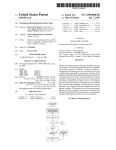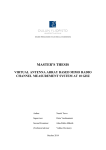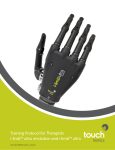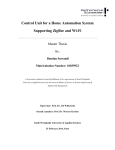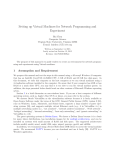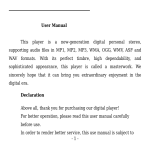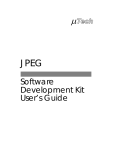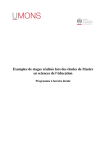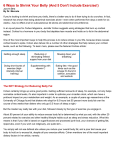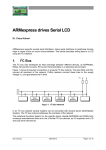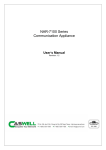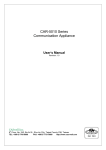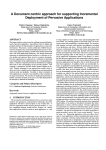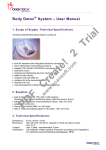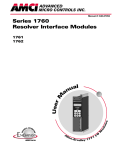Download - University of Huddersfield Repository
Transcript
University of Huddersfield Repository Ghabar, Omar and Lu, Joan Remote Control and Monitoring of Smart Home Facilities via Smartphone with Wi-Fly Original Citation Ghabar, Omar and Lu, Joan (2015) Remote Control and Monitoring of Smart Home Facilities via Smartphone with Wi-Fly. In: Proceedings of The Fifth International Conference on Advanced Communications and Computation. INFOCOMP (2015). IARIA, Brussels, Belgium, pp. 66-73. ISBN 978-1-61208-416-9 This version is available at http://eprints.hud.ac.uk/25375/ The University Repository is a digital collection of the research output of the University, available on Open Access. Copyright and Moral Rights for the items on this site are retained by the individual author and/or other copyright owners. Users may access full items free of charge; copies of full text items generally can be reproduced, displayed or performed and given to third parties in any format or medium for personal research or study, educational or not-for-profit purposes without prior permission or charge, provided: • • • The authors, title and full bibliographic details is credited in any copy; A hyperlink and/or URL is included for the original metadata page; and The content is not changed in any way. For more information, including our policy and submission procedure, please contact the Repository Team at: [email protected]. http://eprints.hud.ac.uk/ INFOCOMP 2015 : The Fifth International Conference on Advanced Communications and Computation Remote Control and Monitoring of Smart Home Facilities via Smartphone with Wi-Fly Omar Ghabar Joan Lu School of Computing and Engineering University of Huddersfield Huddersfield, UK e-mail: [email protected] School of Computing and Engineering University of Huddersfield Huddersfield, UK e-mail: [email protected] Abstract— Due to the widespread ownership of smartphone devices, the application of mobile technologies to enhance the monitoring and control of smart home facilities has attracted much academic attention. This study indicates that tools already in the possession of the end user can be a significant part of the specific context-aware system in the smart home. The behaviour of the system in the context of existing systems will reflect the intention of the client. This model system offers a diverse architectural concept for Wireless Sensor Actuator Mobile Computing in a Smart Home (WiSAMCinSH) and consists of sensors and actuators in various communication channels, with different capacities, paradigms, costs and degree of communication reliability. This paper focuses on the utilization of end users’ smartphone applications to control home devices, and to enable monitoring of the context-aware environment in the smart home to fulfil the needs of the ageing population. It investigates the application of an iPhone to supervise smart home monitoring and control electrical devices, and through this approach, after initial setup of the mobile application, a user can control devices in the smart home from different locations and over various distances. Keywords-smartphone; remote control; smart home; ad-hoc; context-aware. I. INTRODUCTION Nowadays, smartphones are becoming increasingly successful in the area of context-aware services, such as smart home technology, computer-assisted homecare and healthcare, and other applications for social and safety purposes. Such services appear to recognise users‟ contexts, for example their location, current activities, identity and surrounding environment [1]. Additionally, there has been rapid growth in the field of remote control home automation, which enables smartphones to be used to control electronic devices in the household. An increasing number of home appliances, such as heating, TVs, lights, washing machines, A/V players and many other products can be embedded with computer technology and controlled by smartphones [2]. There are many forms of accessible media which can be used for wireless communication by remote control, for example, internet services, SMS with GSM, mobile phones and multi agent systems (MAS). These systems allow different actions to be performed, such as switching a device on or off, Copyright (c) IARIA, 2015. ISBN: 978-1-61208-416-9 controlling the level of sound or temperature and other functions. Such wireless networks of sensors and actuators [3][4] have become an area of active research. Sensors and actuators can be used to improve the interaction between the client and the physical environment. It is thought that by 2020 [5], there will be between 50 and 100 billion appliances connected to the internet. Researchers are trying to promote changes to the mode by which each object is activated [6]. In addition to sensor technology, the mobile phone has become increasingly powerful in the field of computing as well as that of communication. This paper defines and explains the design of an iPhone smart home system, using the Wi-Fly module, for monitoring safety in the home environment as well as for controlling electronic appliances in the same house. In effect, therefore, the prototype system is responsible for both monitoring and control, so this research offers a mixture of these two functions. The model is highly flexible and can be applied to several areas of study. This study describes the smart home architecture that can remotely monitor home devices and also provide real-time monitoring of home safety status through the implementation of a smartphone. It focuses on a system which ensures a high level of service for the intelligent home, including activity delay when the resident leaves the building. Thus, the proposed system provides a personal device for monitoring and control of different circumstances through the iPhone interfaces which are used to process context-aware information. The main benefit of the iPhone, compared to the use of a PC, is that it can be used from different locations. Various context-aware data, to be monitored using Wi-Fly, were tested in the laboratory using the iPhone. There are very few studies offering a complete explanation of the actuators, sensors and robotics built into context-aware system design, as this field includes a wide variety of technologies and also requires several application situations which might be difficult to provide and assess. Analysis of specific problems is still at the theoretical stage, and few critical studies have yet offered a clear and extensive description relating to quality of context [7]. There has also been little previous research and development work carried out into aspects of the smart home, and even the number of users has not been clearly determined. Most research has concentrated on feasibility 66 INFOCOMP 2015 : The Fifth International Conference on Advanced Communications and Computation studies and the use of interactive communication technologies with context-aware applications [8]. This prototype design attempts to offer a solution for the challenges relating to wireless sensor/actuator mobile computing in a smart home. In designing and implementing the architecture of the technologies for such a system, it is therefore important to incorporate the sensors and actuator devices for computational issues which support the occupants‟ interaction with the physical environment. In the course of this study, a general context-awareness model is investigated, as well as technological solutions that have the capability of sensing, monitoring and controlling automation in the smart home. The remaining sections of the paper are structured as follows. Section II describes related studies with respect to wireless sensor/actuator and mobile computing in the smart home. Section III presents the system architecture for the proposed model, comprising Wi-Fly adapter, sensors, actuators, microcontroller unit, end user and database server. Section IV outlines the infrastructure for wireless adapter network implementation, Section V defines techniques to set up application control for both the smartphone and the embedded system, and Section VI offers the smartphone interfaces. Section VII considers and evaluates the results and finally, Section VIII provides the conclusion and suggestions for future work. II. RELATED WORK Wireless technologies in the smart home have been studied by many researchers. These studies have used different types of wireless technology, such as Wi-Fi, IEEE 802.15.4, Bluetooth, GSM, ZigBee and Konnex RF (KNXRF), [9][10][11][12], and much progress is currently being made on this issue. One of the most popular examples is the use of wireless sensors and actuators [13], but different kinds of technology and home automation devices have been integrated with different wireless protocols for ease of use in control and data gathering. Studies by Hoof et al. [14] show that trends in smart home technology are based on the technical potential of their function, but are seldom focused on the needs and requirements of residents. Therefore, new techniques must take into account the attitudes of occupants and earn their approval of intelligent home equipment, particularly in the context of provision for the aging and disabled population. In general, smart home technologies in the residential environment require five things to make them „smart‟, which are wireless technology, home automation, remote control, intelligent control and a database. The most important features of this technology are the actuators and sensors. An actuator is used to create an action according to the data collected by sensors, which are used to decide the action. Currently, developments in technologies permit inhabitants to control home appliances without difficulty by operating devices such as a remote control, smartphone or PC through a mere click. The smart home prototype is typically based in a house, with a convenient Copyright (c) IARIA, 2015. ISBN: 978-1-61208-416-9 wireless communication system, security and energy saving power source to reduce the input of the user. Smart home automation is an important subject; it refers to the automatic control of equipment and devices in the smart home environment. Many studies have proposed designs for the system and even smart home products [15]. In the system of intelligent home equipment and appliances, human control is generally easy. A home automation system typically includes an internal network, and practical and intelligent rules and equipment for specific use in the home network. Systems and equipment can be controlled automatically and used to provide information on the home automation environment. Another facility is that changing the state or mode of a device can change or trigger other devices in the smart home environment [16]. An article by Alheraish describes the design of a remote control model entitled Mobile to Machine (M2M), based on the GSM network. The system consists of an embedded system, sensor, relay and a mobile to control home brightness, monitoring and security issues. Some advantages were observed during the experimental stage of this model; for example, the system has the ability to use different techniques such as SMS and GPRS, and it is appropriate for simple applications using ADC or DAC. On the other hand, it also has some drawbacks for which the designer needs to find suitable solutions. It will be difficult to make the model M2M viable before the solutions to these problem are found [17]. Another study by Acker and Massoth describes a system design solution for monitoring and controlling smart home technologies, and also for secure access, via smartphone. The model system involves a variety of techniques and equipment to control home devices, such as a BlackBerry smartphone, a sensors box (Allnet ALL 4000) and BlackBerry Enterprise Solution. The appliances connected included TV and Hi-Fi, and Java Development Environment (JDE) software was used. The results which they report include three different settings of access time and show respectable results in terms of usability. However, the drawback was that the BlackBerry smartphone software would need to be regularly updated from BES in order to maintain a high level of usability [18]. Das et al.‟s [19] study makes specific reference to the circumstances of intelligent home security using smartphones. They were able to remotely contact and control electronic security devices and integrate other services. This study managed home automation and security (HASec) through the design and implementation of smartphone devices‟ processing systems, demonstrating that mobile technology can be used to provide the necessary security for products as well as operations related to control. The HASec system permits different types of mobile phone to access the full Web browser. Within the smart home setting, one very important development would be to make context-aware applications available which could assist older people, by making them more comfortable and making the activities of daily life easier. To succeed in this goal, the current study seeks to 67 INFOCOMP 2015 : The Fifth International Conference on Advanced Communications and Computation incorporate various advances in technology into the smart home prototype. III. SYSTEM DESIGN AND IMPLEMENTATION Figure 1 illustrates the comprehensive system architecture from the viewpoint of communication, electronic devices and data management. These aspects are described in the following sections. A. Sensors Design There are different types of sensors and actuators involved in the prototype system. They can also be used to obtain a context using systems embedded in the smart home environment. These sensors include an obstacle avoidance sensor; smoke sensor; human detection sensor; brightness sensor; humidity sensor; ultrasonic distance sensor; and sound sensors (see Figure 2 for the different types of sensors used in the system design). The main aim of this function is to transfigure real physical variables into digital variables, which are then processed in the computing system. The acquisition of this type of context will need features such as a wireless adapter, sensors, an embedded system and the end user client. More detail can be found in [20]. These communication requirements are based on a microcontroller which needs to be adapted with a Universal Asynchronous Receiver Transmitter (UART) [18]. This is an appliance that transmits and receives raw information from the choice of MCU to support low level programming language C. D. Relay (Actuators) Function An actuator (SRD-05VDC-SL-C) is an electrical advice used to control electronic appliances by opening or closing the switches of other circuits. It has an electromagnetic coil to operate the switch in two positions, ON or OFF. It is activated by signal or electric current that flows through the coil, as a result of which the magnetic field attracts an armature. Once the current to the loop is interrupted, the armature is about twice as strong as the magnetic force to return it to its relaxed situation. This actuator is designed to be operated with DC voltage, and the diode on the coil is often installed to disable the magnetic field from disappearing. Most actuators are designed to trigger as quickly as possible to achieve the actions. Figure 3 shows the relay device used in this research and its connection with other electrical and electronic devices in the lab. B. Wi-Fly (RN-370) The wireless adapter is powered by an external AC to 5V DC and two AAA batteries, which can run up to eight hours on full charge. The device is connected using only a RS-232 serial port interface of the DB9. It receives information from sensors over the MCU, and then sends this information to end devices, such as an iPhone or PC. The data is also transferred over a reliable TCP/IP socket using an ad-hoc or infrastructure network. C. Microcontroller Unit (Logic Converter): The STC89Cxx series MCU is an important part of the system design, as it is an 8-bit single-chip microcontroller. This chip is compatible with outlying device communication that monitors resident activity and motion by gathering data from sensors, interfaced with the Wi-Fly wireless transceiver and embedded with 64K bytes flash memory to store data, which is shared with In-system Programming (ISP). It also has an In-System Application (ISA) to assist the operator. Figure 1. Framework layers in the prototype system. Copyright (c) IARIA, 2015. ISBN: 978-1-61208-416-9 Obstacle Avoidance Sensor Light (Brightness) Sensor Ultrasonic Distance Sensor Human Body Sensor Humidity Sensor Smoke Sensor Temperature Sensor Sound Sensor Figure 2. Smart home sensors design. Figure 3. The MCU, WI-Fly RN-370 and four actuators connected to LEDs and fans. 68 INFOCOMP 2015 : The Fifth International Conference on Advanced Communications and Computation IV. WIRELESS CONNECTION OF THE ACTUATORS AND SENSORS The prototype system in the smart home area is described by the diagram in Figure 4. The connection and communications are variable to enable low cost electronics to be employed for the design and implementation of the system. The Wi-Fi network is employed to make the connection between the electronic devices, as it is widely available in most home areas. The sensors and actuators are connected by wireless infrastructure to collect the data from the sensors and perform the control actions. The wireless adapter module RN-370 supports ad-hoc and infrastructure networking modes. The user interacts with the system using her/his smartphone. The requirements for the wireless prototype are given in Table I. The computing of the context data is done by the computer service and the decisionmaking algorithms. A. Ad-hoc Configuration To configure the ad-hoc mode, the Wi-Fly adapter needs to be set up for the ad-hoc network within the hardware or software instructions. To permit the ad-hoc network to establish communication with a smartphone through hardware, switch 1 must be turned ON. There are different kinds of connection available to create Wi-Fi applications, for example, remote environment sensors; control and monitoring of appliances; diagnostics; and mobile phone connections, such as GPS. Therefore, Wi-Fly configurations can be set as peer-to-peer (ad-hoc) networking to an iPhone, by using the IP address (169.254.1.1) and subnet mask (255.255.0.0), with the need to set the Service Set Identifier (SSID) and Wi Fly-GSX 21 in a wireless mobile computing network [21]. B. Infrastructure Configuration To configure the infrastructure mode using software to start communication and associate the network, it is necessary to set up two commands for the wireless adapter, (1) to start an automation connection with a server and (2) to establish automated tracking of a connection from the remote host [21]. These setups need the Chortle series access point (1100) to connect the infrastructure network with the database server. When wireless communication for the local area network is set up using a Wi-Fly adapter, the device will automatically connect to the network. For context update and request to the network, the following commands are used: ($$$); type 3 dollar signs to see message with CMD. Scan; scan available wireless network. Set wlan ssid chortle; ask to join the network. Set ip proto; turn HTTP mode=0x10 and TCP mode=0x02. Set ip host 10.0.0.11; web server DSN Set ip remote 80; set web server port. Set sys autoconn 1; automatically connect. Set com remote GET$/work2/allsensors.php? Sample server application. Set uart mode 2; automatically trigger mode. Save and reboot; save configuration and restart. Copyright (c) IARIA, 2015. ISBN: 978-1-61208-416-9 TABLE I. ELECTRONIC APPLIANCE ENGAGEMENT Appliance Employed Smartphone Appliance Models Functionality iPhone 4 Actuators Relays Receive the information gathered from sensors and control the actuator Switch on or off Sensors Temperature, Sound, Brightness, Smoke, Humidity, Distance, Human Body and Obstacle Avoidance Wi-Fly RN-370 Wireless adapter Embedded system MCU-STC89C52RC Wireless access point Home automation Chortle (Cisco Aironet 1100). Fan and Light Gathering data from home environment Transfers information written or read to the successive interface Collect data from sensors and preprocess raw data Wireless network. Brightness and cooling Figure 4. Wireless communications over ad-hoc and infrastructure networks. V. APPLICATION CONTROL FOR BOTH MICROCONTROLLER UNIT AND IPHONE A. Function to Control Microcontroller Unit The device can be used to control actions by, for example, sending a message via the mobile or keyboard including specific characters such as letters and numbers. The software program should decode the character message to be compatible with other details regarding the electronic appliances to be controlled. The action control can be accomplished through the output of the microcontroller unit after running the software program and passing the complier through the test program in Debugger (Keil uVision3) for the debugger instruction. At the same time, the program will also 69 INFOCOMP 2015 : The Fifth International Conference on Advanced Communications and Computation run in STC-ISP.exe, after selecting the hex file and the port from the PC to be ready for sending the character or action over wired and wireless technology. The following function may be used to control home devices: If (OnOff=='0') RELAYL1 = 0x00; If (OnOff=='a') RELAYL1 = 0xFF; B. Function to Control iPhone The iPhone 4 SDK (version IOS 6.1.3), and Apple iMac version 10.7.5 run with Xcode version 4.6.2, were used in this experiment. Objective-C and Cocoa Touch were the programs most implemented in this part of the project, with Cocoa Touch used by Objective-C offering the structure for iPhone application. One of the most important applications for the iPhone is the connection of the CFSocket function to create a TCP socket, as well as to set up the communication over the ad-hoc network. For a low level structure, the first step is to build the socket context, the second is to create the service socket as a TCP and set a callback, and the third is to set a local address which is used to connect the socket to the server. The final step, when the interface for remote home control is linked up, is to offer options for action. For example, the user may decide whether the residence needs to switch on or off electronic devices, such as lights, fan, heater or speakers, or all the appliances together. For the first step of remote control, the code used involves simple „IF‟ and „ELSE‟ statements to regulate this. When the IF statement is defined, UIwatViewController „on‟ status is set to character „0‟, and when the ELSE statement is defined, UIwatViewController „off‟ status is set to character „a‟. The same function can be used for the remaining devices, e.g.: - (IBAction) switchLight1ValueChanged:(id)sender { NSString *typecode; If (watViewController.switchLight1.on) typecode = @"0"; else typecode = @"a"; [alert release]; }} section describes the smartphone (iOS) interface used to offer the implementation of context-aware services using the functions in the model system. The sensing data is first collected by the MCU, and then sent to the smartphone via the Wi-Fly transceiver, as shown in Figure 6. The figure shows the last observations of the experiment exploring the gathering of information from sensors using the Wi-Fly serial adapter and iPhone. (b) (a) (c) Figure 5. Smartphone (iOS) interface for smart home application. VI. MOBILE APPLICATION INTERFACES A mobile application in a smart home system is a critical interface between the consumer and the computer system. It implements residents‟ control commands and gathers context-aware information using HTTP protocol, as well as SPLIT and POST functions. Three of the selected prototype systems (iOS) for the apparatus are as follows. In Figure 5, which is a sample data interface, (a) is a login screen interface, (b) is a context monitor screen interface and (c) displays the status of the device and the control interface. The system design uses parts of the embedded system, sensors/actuators, and a smartphone located in the smart home environment to control home electrical devices using home automation within a context-aware computation service prototype. This Copyright (c) IARIA, 2015. ISBN: 978-1-61208-416-9 Figure 6. Values collected from seven sensors by iPhone. 70 INFOCOMP 2015 : The Fifth International Conference on Advanced Communications and Computation Time Spent (Microsecond) A. Monitoring Environment In order to investigate the performance of the monitoring and control model within a real time environment situation, the iPhone was used to examine and test access time over various distances. The experiment concentrated on the time period required to connect the Wi-Fly access with the smartphone to remotely gather data from the lab environment and to remotely control the prototype automation system. In this test, the iPhone mobile used was linked to the CFSocket network via ad-hoc wireless communication. The access period was measured five times, and each time the test was initiated when the smartphone holder moved into another location. The distance of measurement ranged from 1 metre to 25 metres, and the Wi-Fly function on the iPhone was updated to start the collection of information from the sensors. Once the prototype sensors were connected with the TCP/IP socket, an indication of whether the network was connected or not was given by receiving the notification of “Connection is successful, please login” or “Connection is not successful, please try again”. The remote control data gathering would begin when a successful connection was established. The results in Figure 7 show a statistical examination of the system design used to monitor the smart home environment and the outcome of requests regarding security events. The experiment was repeated five times for each distance. The performance of all service providers already in Wi-Fly networks were tested and showed good stability in terms of the implementation of a wireless link. Comparisons can be made between the performance of this prototype system, using the results for time response in monitoring the environment and controlling home facilities, with other results for the same situation but using different technologies and methods [14]. Figure 8 shows an evaluation of the results of home environment monitoring using eight sensors and different locations, times and IDs. The average time response using the Wi-Fly 802.11 b/g serial adapter and iPhone smartphone was 5.406 u/s at a distance of 0cm, which increased to 5.838 u/s at a distance of 25m. The signal strength then began to decrease at a distance of 27m. 6 Test1 u/s 5.5 Test2 u/s Test3 u/s 5 Test4 u/s 4.5 Test5 u/s 0m 5m 10m 15m 20m 25m Average u/s Distance (Meter) Figure 7. Time taken to monitor environment by touch screen. Copyright (c) IARIA, 2015. ISBN: 978-1-61208-416-9 Time Spent (Microsecond) VII. TESTING AND EVALUATION 5.9 5.8 5.7 5.6 5.5 5.4 5.3 5.2 5.1 Average u/s 0m 5m 10m 15m 20m 25m Distance (Meter) Figure 8. Average time taken to monitor environment by touch screen. B. Device Control For the home automation function, on the other hand, the performance of the prototype system was able to reach a distance of up to 30m. All the devices could be controlled from 5m to 30m, but after that the system only gained a response from some of the devices, i.e. LED1 and LED2. Table II. TEST RESULTS FOR HOME AUTOMATION Distance 5m 10m 15m 20m 25m 30m All Devices x Fan1 x Fan2 x LED1 LED2 (Note: √ represents acceptable action, x not acceptable action) Table II illustrates the control of four electronic appliances, comprising two fans and two LED lights, using a mobile phone, the Apple iOS 6. It was observed that most of the devices responded to the smartphone function from distances of between 5m and 25m, as shown by the √ symbol. However, when the distance increased to 30m, some devices were unable to respond to the action command, as shown by the symbol x. The test focused mainly on functionality and distance. VIII. CONCLUSION AND FUTURE WORK A. Conclusion This study presents an important part of a prototype system for remote control monitoring of smart home facilities using smartphones and low price commercial sensor equipment. The system architecture presented is a wireless system that may be used to integrate the smartphone of the user with the end devices in the smart home. It is also hypothesised that this system could be used to enhance the comfort and security of an elderly or disabled person living alone. In addition, the different features of the prototype, such as functions elaborated by smart home technologies, have been described, as listed below. 1) A model for the incorporation of sensors, actuators, wireless adapter (WI-Fly RN 370) and computer 71 INFOCOMP 2015 : The Fifth International Conference on Advanced Communications and Computation services for remote control in the smart home environment has been theoretically and practically demonstrated. 2) Home automation has been part of the research, and therefore a number of appliances have been involved in the prototype, such as an actuator to control fans and LED lights using a smartphone. 3) The use of ad-hoc and wireless network infrastructures in this context has been explained. 4) The uses of smartphone applications to achieve smart home automation between the end user and computer service have been described. 5) The mobile programming was run with the iPhone SDK, using the TCP/IP socket to communicate between Wi-Fly and iPhone in order to collect information from sensors and to control home facilities; the effectiveness of this has been tested over a range of distances. This paper has focused on the performance of a prototype system combining context-aware services with the remote control of home appliances. The results show that both monitoring and control of home facilities can be achieved very successfully using a smartphone; information was gathered from all sensors with a very short time lapse of between 5.406 u/s over a distance of 0cm and 5.838 u/s over 25m. Moreover, the smartphone was able to remotely control all the devices over a distance of 5m to 20m, though the fans failed to respond to the action command over 25m. Nevertheless, there are still some difficulties which require further analysis and discussion. B. Future Work Monitoring and automation control of the smart home is an important research application, and may be especially valuable for elderly people who live alone. The target is clearly to provide a good service and environment by employing advanced technology and methods. The goals for future work must be case-based reasoning, taking into consideration the needs and requirements of the elderly or disabled end user, and decision-making rules regarding the information required from various sensors and how this is used to control electrical devices. The precise nature of the set of rules, and the influencing factors within various sets of context-aware information, may be calculated and determined using methods such as a Bayesian network. Another future piece of work should be to use computing algorithms to investigate the quality of the context which has been created using information from various sensors. [3] [4] [5] [6] [7] [8] [9] [10] [11] [12] [13] [14] [15] [16] [17] [18] REFERENCES [1] A. Sashima, Y. Inoue, T. Ikeda, T. Yamashita, and K. Kurumatani, "CONSORTS-S: A mobile sensing platform for context-aware services," in Intelligent Sensors, Sensor Networks and Information Processing (ISSNIP), International Conference on, 2008, pp. 417-422. [2] J. Nichols, et al., "Generating remote control interfaces for complex appliances," in Proceedings of the 15th Annual Copyright (c) IARIA, 2015. ISBN: 978-1-61208-416-9 [19] [20] ACM Symposium on User Interface Software and Technology, 2002, pp. 161-170. F. Xia, Y.-C. Tian, Y. Li, and Y. Sung, "Wireless sensor/actuator network design for mobile control applications," Sensors, vol. 7, 2007, pp. 2157-2173. S. Yan, C. Qiang, and L. Hong, "Smart home based on wireless sensor-actuator networks," China Communications, vol. 8, 2011, pp. 102-109. W. Lumpkins, "The internet of things meets cloud computing [Standards Corner]," Consumer Electronics Magazine, IEEE, vol. 2, 2013, pp. 47-51. L. Trappeniers, M. A. Feki, F. Kawsar, and M. Boussard, "The internet of things: the next technological revolution," Computer, vol. 46, 2013, pp. 0024-25. P. Bellavista, A. Corradi, M. Fanelli, and L. Foschini, "A survey of context data distribution for mobile ubiquitous systems," ACM Computing Surveys (CSUR), vol. 44, 2012, p. 24. D. Ding, R. A. Cooper, P. F. Pasquina, and L. Fici-Pasquina, "Sensor technology for smart homes," Maturitas, vol. 69, 2011, pp. 131-136. N. Langhammer and R. Kays, "Evaluation of wireless smart metering technologies in realistic indoor channels," Wireless Communication Systems (ISWCS), 2011 8th International Symposium on, 2011, pp. 387-391. T. Han, B. Han, L. Zhang, X. Zhang, and D. Yang, "Coexistence study for WiFi and ZigBee under smart home scenarios," Proc. 3rd IEEE International Conference on Network Infrastructure and Digital Content, 2012, pp. 669674. S. O. Al Mehairi, H. Barada, and M. A. Qutayri, "Integration of technologies for smart home application," ed, 2007, pp. 241-246. Y. Tajika, T. Saito, K. Teramoto, N. Oosaka, and M. Isshiki, "Networked home appliance system using Bluetooth technology integrating appliance control/monitoring with Internet service," Consumer Electronics, IEEE Transactions on, vol. 49, 2003, pp. 1043-1048. J. Zhang, G. Song, H. Wang, and T. Meng, "Design of a wireless sensor network based monitoring system for home automation," ed, 2011, pp. 57-60. J. Van Hoof, H. Kort, P. Rutten, and M. Duijnstee, "Ageingin-place with the use of ambient intelligence technology: Perspectives of older users," International Journal of Medical Informatics, vol. 80, 2011,pp. 310-331. C. Kühnel, T. Westermann, F. Hemmert, S. Kratz, A. Müller, and S. Möller, "I'm home: Defining and evaluating a gesture set for smart-home control," International Journal of HumanComputer Studies, vol. 69, 2011, pp. 693-704. Y.-W. Kao and S.-M. Yuan, "User-configurable semantic home automation," Computer Standards & Interfaces, vol. 34, 2012, pp. 171-188. A. Alheraish, "Design and implementation of home automation system," Consumer Electronics, IEEE Transactions on, vol. 50, 2004, pp. 1087-1092. R. Acker and M. Massoth, "Secure ubiquitous house and facility control solution," in Internet and Web Applications and Services (ICIW), 2010 Fifth International Conference on, 2010, pp. 262-267. S. R. Das, S. Chita, N. Peterson, B. Shirazi, and M. Bhadkamkar, "Home automation and security for mobile devices," in Pervasive Computing and Communications Workshops (PERCOM Workshops), 2011 IEEE International Conference on, 2011, pp. 141-146. O. Ghabar and J. Lu, "The Designing and Implementation of a Smart Home System with Wireless Sensor/Actuator and Smartphone," INFOCOMP 2014, The Fourth International 72 INFOCOMP 2015 : The Fifth International Conference on Advanced Communications and Computation Conference on Advanced Communications and Computation, 2014, pp. 56-64. [21] R. Networks. (2010, WiFly Serial Adapter RN-370 & RN374. Install Guide and User Manual 1.00, pp.1-21. Available: www.rovingnetworks.com Copyright (c) IARIA, 2015. ISBN: 978-1-61208-416-9 73










